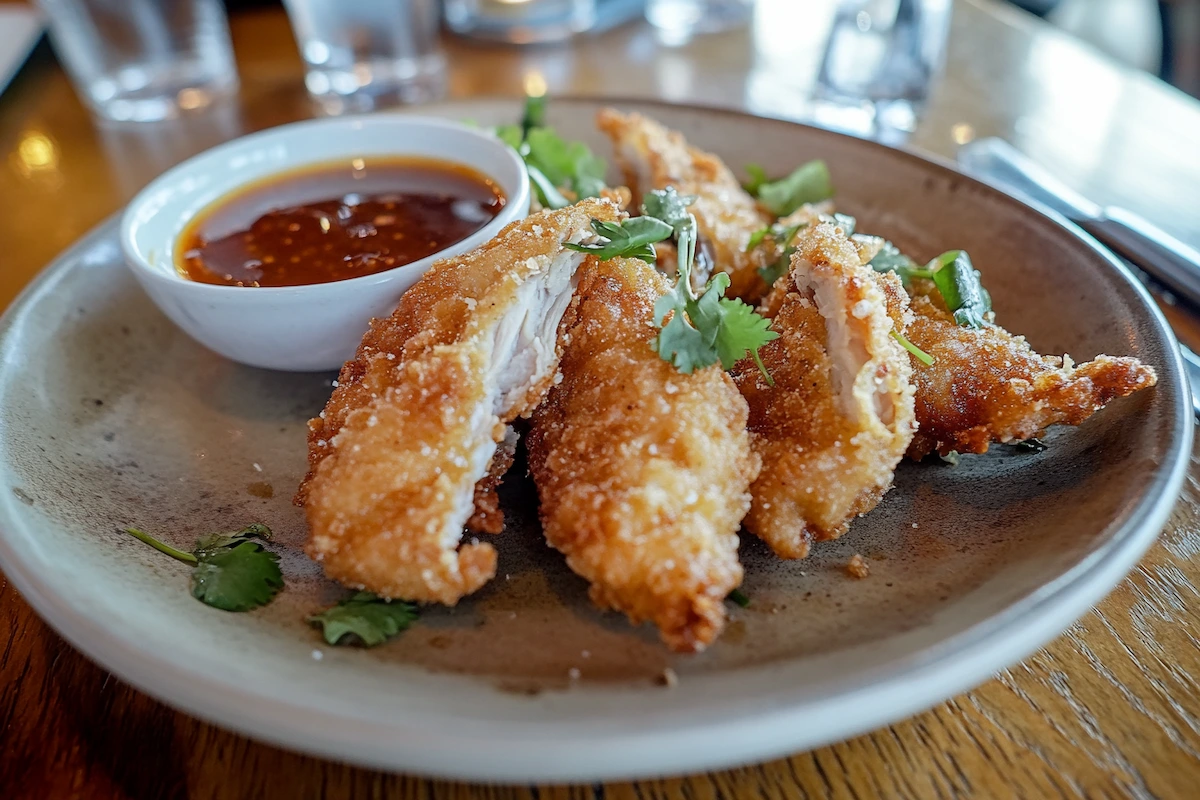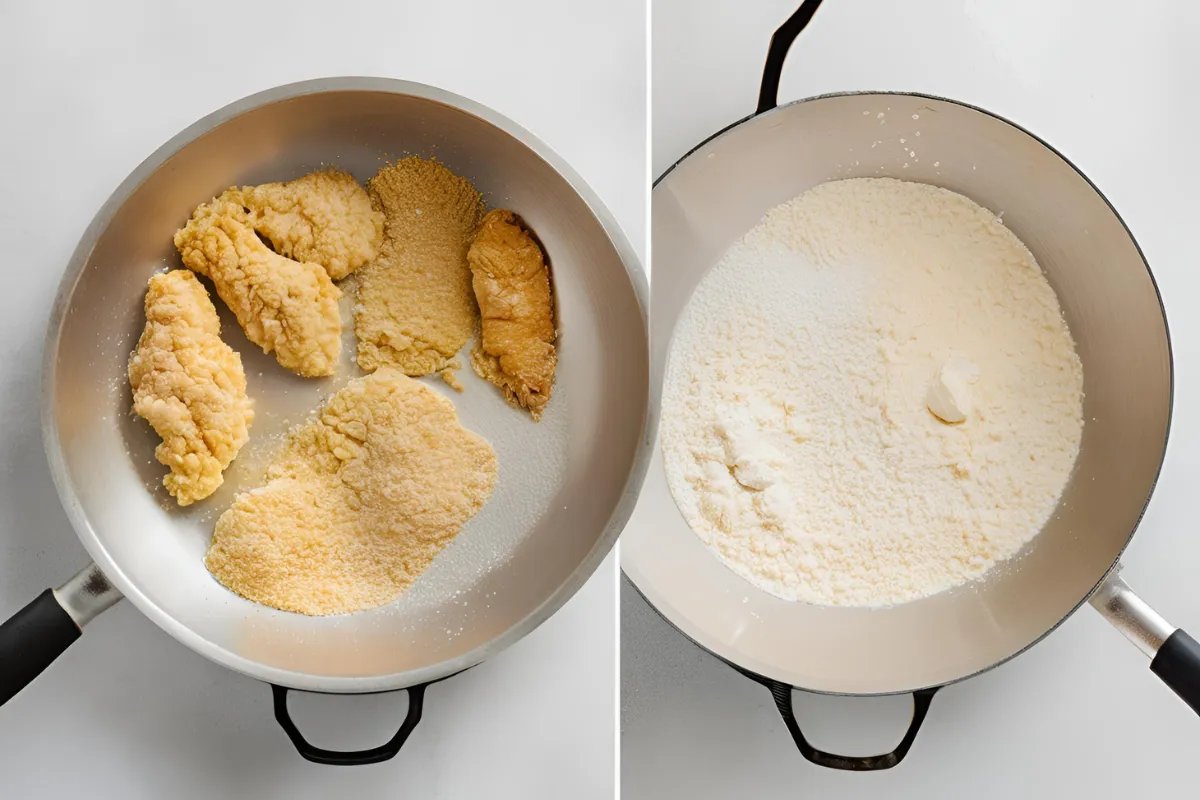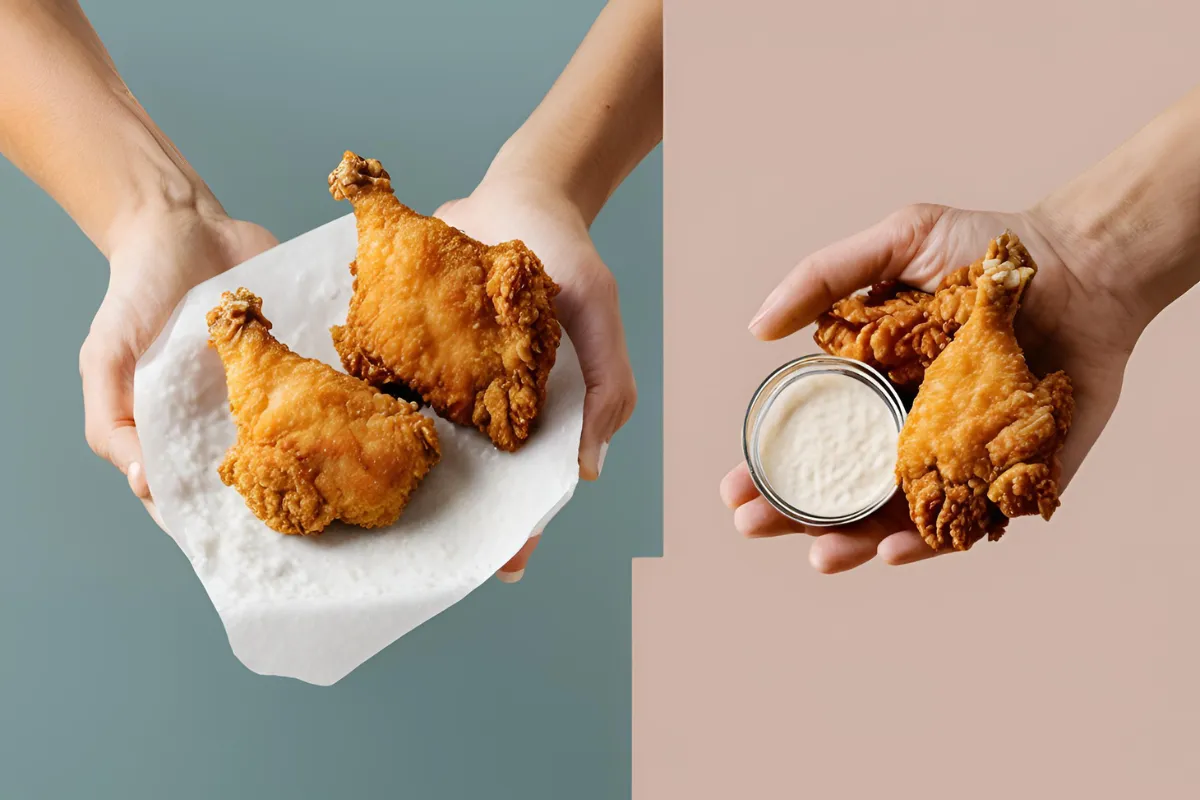Introduction to the Debate: Cornstarch or Flour?
Do you use cornstarch or flour to fry chicken? It’s a common dilemma in the kitchen that can significantly affect the texture and flavor of your fried chicken. While flour has been the traditional choice, cornstarch is gaining popularity for its ability to create a lighter, crunchier finish. The key is balancing crispiness and flavor. Each ingredient offers something unique, and understanding how they interact with heat and oil is essential for achieving the perfect fried chicken.
What is Flour and How Does it Affect Fried Chicken?
Flour is the most traditional ingredient used to fry chicken. It’s been the go-to choice for generations, particularly in Southern fried chicken recipes. The primary function of flour is to create a thick, crunchy coating that holds seasonings in place, sealing in the moisture and flavor of the chicken. Most fried chicken recipes call for all-purpose flour, although some variations use self-rising flour or a combination of flour and cornmeal.
Flour works well for creating a hearty, substantial coating. When the chicken is dredged in flour and fried, the flour absorbs moisture from the chicken and the oil, helping form a crisp, golden-brown crust. However, this same moisture absorption can sometimes result in a heavier, oil-saturated crust if not fried correctly. The key to achieving the ideal crispy finish is maintaining the proper oil temperature—too hot and the coating may burn; too cold and the coating may absorb too much oil, leading to sogginess.
What is Cornstarch and How Does it Affect Fried Chicken?
Cornstarch, on the other hand, is a fine, powdery substance made from corn kernels. It’s traditionally used as a thickening agent in sauces and soups, but in frying, it offers a much lighter, crunchier texture than flour. Cornstarch doesn’t absorb moisture in the same way flour does, making it an excellent choice for those who prefer a crisp, delicate coating. Because of its fine texture, cornstarch produces a thinner coating that crisps up beautifully in the hot oil.
One of the biggest advantages of using cornstarch is its ability to create an airy, crispy exterior that stays crunchy even after the chicken has cooled. This is especially advantageous for people who prefer fried chicken that doesn’t lose its crispiness over time. Furthermore, since cornstarch is gluten-free, it’s a great option for those avoiding gluten. However, cornstarch does not absorb flavors as well as flour, which means you might need to add additional seasoning or combine it with other ingredients to enhance the flavor profile.
Key Differences Between Cornstarch and Flour for Frying Chicken
The main differences between cornstarch and flour when frying chicken lie in texture, flavor, moisture retention, and crispiness:
- Texture: Flour creates a thicker, denser coating, which provides a hearty crunch. It’s perfect for those who enjoy a substantial, crispy bite. On the other hand, cornstarch results in a lighter, crispier texture that tends to stay crisp longer, even after cooling.
- Flavor: Flour has a superior ability to absorb seasonings, making it an ideal choice for those who want bold, flavorful fried chicken. Cornstarch is more neutral in flavor, so it doesn’t absorb as much of the seasoning, which can require extra seasoning to make up for it.
- Moisture Retention: Cornstarch is better at retaining moisture in the chicken, leading to a crisp finish without absorbing as much oil. Flour, on the other hand, tends to absorb more moisture, which can result in a heavier coating that may feel greasy if not fried properly.
- Crispiness: Cornstarch wins when it comes to crispiness. The fine texture of cornstarch creates a delicate yet crunchy finish, while flour provides a thicker, more substantial crunch that may soften quicker than cornstarch.
In essence, the decision between flour and cornstarch depends on the texture and flavor you prefer in your fried chicken. If you want a thicker, more flavorful crust, flour may be the better choice. But if you’re looking for a lighter, crispier finish, cornstarch is the way to go.
Advantages and Disadvantages of Using Flour
Flour is a staple in most kitchens and has long been associated with classic fried chicken recipes. The advantages of using flour for frying include its versatility, ease of use, and ability to absorb seasonings. Flour helps create a hearty, flavorful coating that provides a satisfying crunch. It’s easy to work with and doesn’t require any special techniques. For home cooks, flour is a reliable option that can be used with a wide range of seasonings.
However, there are some drawbacks to using flour. If the chicken is not fried properly, the coating can become greasy or soggy. Since flour absorbs moisture from both the chicken and the oil, it can result in a dense coating if not cooked at the proper temperature. Additionally, flour can sometimes fail to provide the ultra-light, crunchy texture that some people desire, especially when compared to cornstarch.
To mitigate some of these issues, many chefs and home cooks opt for variations in their flour-based coatings. Some combine flour with other ingredients, such as cornmeal, breadcrumbs, or potato starch, to enhance the texture and flavor of the fried chicken. Additionally, seasoning the flour mixture is crucial to adding flavor to the fried coating. Garlic powder, paprika, cayenne, and other spices can be mixed into the flour for extra flavor.
Advantages and Disadvantages of Using Cornstarch
Cornstarch, on the other hand, has risen in popularity for its ability to produce a crisp, light, and airy coating. It creates a delicate, crunchier finish that stays crispy longer than flour. For those who prefer a less greasy, lighter fried chicken, cornstarch is an excellent choice. It also works well for gluten-free fried chicken, making it a versatile option for those with dietary restrictions.
The main downside to using cornstarch is its inability to absorb seasoning as effectively as flour. As a result, it might require additional seasoning or the use of other ingredients like rice flour or potato starch to add flavor. Cornstarch also requires a bit more care during the frying process, as it can be tricky to work with. If the oil temperature is too low or too high, the coating may not fry evenly.
Combining Flour and Cornstarch for the Ultimate Fried Chicken
Many chefs recommend combining both flour and cornstarch to get the best of both worlds. By mixing flour’s ability to absorb flavors with cornstarch’s crispiness, you can create a coating that is both flavorful and ultra-crispy. The flour provides substance and flavor, while the cornstarch adds the delicate, crunchy finish that stays crisp longer.
The combination of both ingredients is particularly useful for those who want a hearty, flavorful coating with a light, airy crunch. You can experiment with different ratios of flour to cornstarch depending on the desired texture and flavor profile. A common starting point is a 2:1 ratio of flour to cornstarch, but this can be adjusted based on your personal preferences.
The Perfect Frying Method – Flour or Cornstarch?
Achieving the perfect, crispy fried chicken is the ultimate goal for many cooks, whether they are seasoned chefs or home cooks. The key to that crispy crust often comes down to one of two ingredients: flour or cornstarch. Each ingredient has its strengths, and the method you choose will depend on the texture and flavor you’re aiming for. In this guide, we’ll walk through the steps for frying chicken with both flour and cornstarch, and explore how combining both ingredients can yield the ultimate fried chicken.
How to Fry Chicken with Flour
Using flour for frying chicken is a classic method that has been beloved for generations. All-purpose flour or self-rising flour are the most common choices for creating a thick, golden-brown coating. Here’s how to get the best results when using flour:
Prepare Your Chicken
Start by seasoning your chicken well with spices like garlic powder, paprika, salt, pepper, and cayenne for a flavorful coating. Many cooks brine their chicken in buttermilk to enhance tenderness and flavor. The longer the chicken sits in the brine, the juicier it will become.
Dredge the Chicken
Set up a dredging station with a shallow bowl or plate filled with flour. To increase the crispiness, you can mix a bit of cornstarch into the flour. Coat each piece of chicken evenly, making sure to shake off any excess flour to prevent clumping.
Heat the Oil
In a deep frying pan or skillet, heat vegetable or peanut oil over medium-high heat. You can test the oil’s temperature by dropping a small amount of flour into the oil—if it sizzles immediately, the oil is ready.
Fry the Chicken
Carefully lower the chicken into the hot oil, ensuring the pieces aren’t overcrowded. Fry the chicken in batches if necessary, cooking for about 12-15 minutes, turning occasionally, until the chicken reaches an internal temperature of 165°F and the coating is golden brown.
Drain the Chicken
Once fried, place the chicken on a wire rack or paper towels to drain excess oil. Let it rest for a few minutes so the crispy texture remains.
Tips for Crispiness
- Make sure your oil is hot enough; cooler oil can make the coating soggy.
- Use a wire rack to drain the chicken, which allows air circulation and keeps the coating crisp.
- Avoid overcrowding the pan to ensure even cooking and prevent temperature drops.
How to Fry Chicken with Cornstarch
If you’re looking for a crispier, lighter finish, cornstarch may be the perfect choice. This method results in a delicate, crunchy coating that’s less greasy and stays crisp for longer.
- Prepare the Chicken
Season the chicken well, just as you would when using flour. Keep in mind that cornstarch doesn’t absorb seasoning as efficiently as flour, so you might need to season more heavily or season the coating itself. - Coat the Chicken with Cornstarch
Place cornstarch in a shallow bowl or plate. For extra crispiness, you can mix cornstarch with rice flour or potato starch. Coat each piece of chicken evenly in the cornstarch mixture, tapping off any excess to avoid clumps. - Heat the Oil
Heat oil in the pan to about 350°F. Cornstarch requires high heat to achieve the desired crunch, so it’s essential to ensure the oil is hot enough. - Fry the Chicken
Lower the chicken into the oil, frying for about 10-12 minutes. Turn the chicken occasionally until the coating is golden and crunchy. Check that the internal temperature reaches 165°F. - Drain and Rest
Once fried, remove the chicken and place it on a wire rack. Let it rest for a few minutes to ensure the coating remains crispy.
Important Considerations for Cornstarch
- The oil temperature should remain around 350°F for the best crispy result.
- Keep the coating thin and even to avoid a too-thin or flaking crust.
- Since cornstarch doesn’t absorb flavors as well, season the chicken more generously.
Combining Flour and Cornstarch for the Ultimate Fried Chicken
Many chefs recommend combining both flour and cornstarch for the ultimate fried chicken. This combination gives you the best of both worlds: the flavor-absorbing properties of flour and the light, crispy finish from cornstarch. Here’s why:
- Flavor Absorption from Flour: Flour captures and holds onto spices and seasonings, providing a flavorful coating.
- Crispiness from Cornstarch: The cornstarch lightens the texture and adds an extra crispiness to the coating.
A common ratio for mixing the two ingredients is 2 parts flour to 1 part cornstarch. This balance provides a coating that’s thick enough to hold flavors and thin enough for a light crunch. If you prefer an even crispier finish, you can adjust the ratio, but too much cornstarch may cause the coating to become too thin.
Benefits of the Flour-Cornstarch Combo
- This mixture ensures that the coating is both flavorful and crispy.
- The resulting coating stays crunchy for longer, even after cooling.
- It’s ideal for people who want a hearty, flavorful exterior with a delicate crunch.
FAQs
- Can You Mix Flour and Cornstarch to Fry Chicken?
Yes! Mixing flour and cornstarch creates a crispy and flavorful coating. Flour gives the coating substance and flavor, while cornstarch makes it crispier and lighter. - What is the Ratio of Flour to Cornstarch for Fried Chicken?
A typical ratio is 2 parts flour to 1 part cornstarch. This gives a good balance of texture and flavor. However, adjust the ratio to your preference for a lighter or denser coating. - Can I Use Cornstarch for Gluten-Free Fried Chicken?
Yes, cornstarch is naturally gluten-free and a great option for those avoiding gluten. You can use it alone or mix it with other gluten-free ingredients like rice flour. - Does Flour or Cornstarch Make the Chicken Crunchier?
Cornstarch makes the chicken crunchier. It provides a lighter, crispier texture, while flour creates a denser, more substantial crust. - How Can I Make Fried Chicken Crispier with Flour?
To enhance the crispiness with flour, double-dip the chicken in a seasoned liquid and then flour. Adding cornstarch to the flour mixture also lightens the texture. Make sure the oil is hot enough to fry the chicken quickly. - How Long Should I Fry Chicken with Cornstarch?
Fry chicken coated in cornstarch for about 10-12 minutes, ensuring the oil temperature stays around 350°F for the best crispy result. - What is the Secret to Good Fried Chicken?
Good fried chicken is all about seasoning, the right coating, and perfect frying. Ensure the oil is hot enough, the chicken is well-seasoned, and use a good coating like flour, cornstarch, or a combination of both. Resting the chicken on a wire rack afterward will help keep the coating crisp.
Conclusion
Whether you choose flour or cornstarch for frying chicken depends on the texture and flavor you prefer. Flour creates a thicker, heartier coating, perfect for those who enjoy a substantial crunch and rich flavor. Cornstarch, on the other hand, provides a lighter, crispier texture, making it ideal for those who prefer a delicate, airy crunch. Many cooks find success by combining both ingredients for the perfect balance of flavor and crispiness.
Perfecting your frying technique—whether using flour, cornstarch, or a mixture of both—ensures your fried chicken is both flavorful and crispy. Enjoy experimenting to find the combination that works best for you and your ideal fried chicken!



